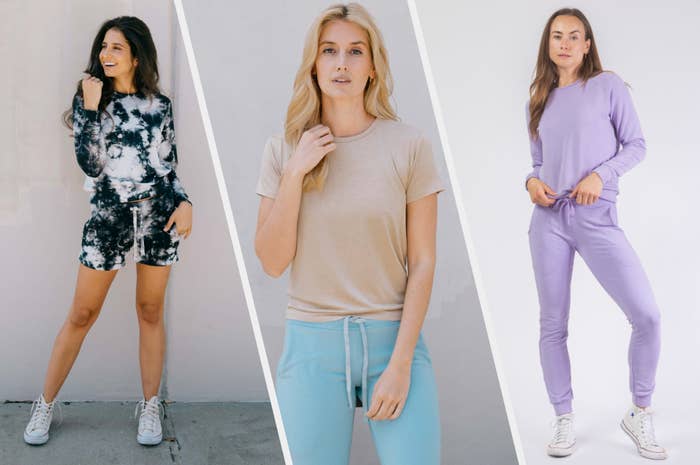How Fabric Choices in Branded Clothing Affect Comfort and Style
How Fabric Choices in Branded Clothing Affect Comfort and Style
Blog Article
Understanding Garments: The Importance of Fabric Options in Your Wardrobe
The choice of fabric in apparel plays a critical function in both aesthetic appeals and performance. Various materials use differing degrees of sturdiness, convenience, and breathability, directly influencing the wearer's experience. Understanding these nuances can enhance one's closet markedly. Yet, numerous overlook how these options can impact not just individual style, but also sustainability. What fabric choices could redefine your wardrobe and align it with both design and responsibility?
The Function of Material in Fashion and Functionality

Common Material Kinds and Their Qualities
When selecting clothing, understanding the attributes of typical textile kinds is essential for making educated options. Cotton, a widely-used natural fiber, is understood for its breathability, softness, and convenience, making it appropriate for informal wear and everyday garments. Linen, another all-natural option, flaunts exceptional moisture-wicking buildings and a distinctive texture, perfect for cozy climates.Wool, usually preferred for its warmth and longevity, varies in fineness; merino wool is soft versus the skin, while coarser kinds are used for outerwear. Artificial textiles like polyester and nylon provide durability and resistance to creases, making them popular for activewear and travel garments. Blends, which combine natural and synthetic fibers, can enhance capability while keeping comfort. By recognizing these textile features, individuals can choose garments that lines up with their lifestyle and visual choices.
Breathability and Convenience: Choosing the Right Fabrics for Different Environments
Picking the right materials for different environments can substantially enhance comfort and overall wearability. Breathable materials are essential in warm environments, as they enable air circulation and moisture dissipation. Fabrics such as cotton, linen, and moisture-wicking synthetics successfully draw sweat away from the body, maintaining the user cool and completely dry. Conversely, in cooler environments, thicker textiles like woollen or fleece provide insulation while preserving breathability, making sure warmth without overheating.Additionally, the choice of material weight plays an essential duty; light-weight materials are more effective for summer, whereas larger alternatives are matched for wintertime wear. Comprehending the distinct buildings of each fabric allows individuals to clothe appropriately for varying weather. Inevitably, picking comfortable and breathable fabrics customized to specific environments can substantially enhance daily comfort and enhance the general experience of wearing apparel.
Resilience and Care: Exactly How Material Influences Longevity of Your Wardrobe
Selecting the appropriate products can considerably impact the toughness and care requirements of a closet. Fabrics such as cotton and polyester are understood for their resilience and convenience of maintenance, making them perfect for everyday wear. In comparison, fragile products like silk and shoelace require even more mindful handling and specialized cleansing methods, which can raise the moment and initiative needed for care. Branded Clothing.Durability is also affected by the textile's weave and surface; snugly woven materials often tend to resist damage far better than freely woven alternatives. In addition, synthetic blends typically provide improved resilience, integrating the most effective qualities of numerous fibers.Understanding the treatment instructions for each fabric is important, as improper washing or drying can bring about early wear. Eventually, selecting sturdy materials can lead to a longer-lasting closet, minimizing the why not try this out regularity of replacements and adding to an extra lasting style choice
The Impact of Material on Fit and Shape

Sustainable Textile Options: Making Eco-Friendly Decisions
The effect of textile extends past fit and shape to encompass environmental factors, motivating a growing interest in sustainable material selections. Green fabrics, such as organic cotton, hemp, and Tencel, are gaining traction among customers who prioritize sustainability in their closets. These products are typically generated with less chemicals and water, lowering their ecological footprint.Additionally, recycled textiles, made from post-consumer waste, use a cutting-edge service to the fabric industry's contamination issue. Brands increasingly embrace openness in their sourcing techniques, permitting consumers to make enlightened decisions regarding their purchases.Choosing sustainable materials not only supports honest methods however also urges the style industry to embrace more liable production approaches. As understanding of environmental concerns increases, individuals are prompted to review the lasting impact of their textile options, promoting a motion in the direction of an extra lasting and environmentally mindful approach to style.
Elevating Design: Just How Textile Can Transform an Attire
While many might concentrate on shade and cut when picking an outfit, the option of textile plays a vital function in elevating design and enhancing total look. Different materials convey distinctive moods and messages; as an example, silk shows deluxe and sophistication, while jeans uses a casual, relaxed vibe. The structure and drape of a material can considerably alter the shape, with structured textiles providing a refined appearance and softer ones creating an extra fluid, loosened up aesthetic.Moreover, the weight of the fabric affects wearability throughout periods. Light-weight textiles like linen and cotton are ideal for summertime, while heavier products such as wool and velour offer warmth and style in colder months. Comprehending fabric residential properties, such as breathability and stretch, also encourages individuals to make informed choices that improve comfort without endangering design. Ultimately, the ideal textile can change an outfit from normal to remarkable, making it a crucial factor to consider in any type of wardrobe.
Regularly Asked Inquiries
How Do I Determine the Textile Web Content of My Garments?
To identify textile web content, one can analyze treatment tags, conduct melt examinations for fiber identification, or seek advice from fabric swatches. These techniques assist set apart products, making certain informed selections for clothing treatment and maintenance in day-to-day wear.
Can Fabric Choice Affect My Mood or Self-confidence?
Textile selection can greatly impact a person's mood and confidence. Branded blog Clothing. Particular products may stimulate feelings of comfort or beauty, while others can really feel uncomplimentary or limiting, ultimately affecting self-perception and emotional health throughout the day
What Fabrics Are Ideal for Sensitive Skin?
For individuals with delicate skin, natural fabrics like bamboo, cotton, and linen are typically advised. These materials are breathable, hypoallergenic, and much less likely to trigger inflammation, making them appropriate options for convenience and skin health and wellness.
How Do I Appropriately Laundry and Look After Various Fabrics?
To appropriately care and clean for various materials, one have to take into consideration each product's details demands, consisting of temperature level settings, cleaning agents, and drying techniques, ensuring long life and maintaining the fabric's original qualities for excellent usage.
Are There Details Fabrics for Athletic or Efficiency Use?
Sports or efficiency wear frequently utilizes fabrics such as polyester, nylon, and spandex. These products see here are made for moisture-wicking, breathability, and flexibility, improving movement and comfort throughout exercises while offering resilience and assistance. On the other hand, in cooler climates, thicker materials like wool or fleece supply insulation while preserving breathability, making sure warmth without overheating.Additionally, the option of textile weight plays an essential role; light-weight materials are preferable for summer season, whereas larger choices are suited for winter wear. In comparison, fragile products like silk and lace require even more cautious handling and specialized cleansing methods, which can increase the time and effort required for care.Durability is likewise influenced by the textile's weave and surface; snugly woven fabrics have a tendency to resist wear and tear better than freely woven alternatives. In contrast, inflexible textiles can restrict movement yet provide a traditional, refined look.Moreover, the density and structure of the textile can affect the visual assumption of body form. The effect of material prolongs past fit and shape to include ecological factors, triggering an expanding passion in sustainable textile options. The structure and drape of a textile can drastically alter the silhouette, with organized materials offering a polished appearance and softer ones creating a much more fluid, unwinded aesthetic.Moreover, the weight of the material affects wearability across seasons.
Report this page